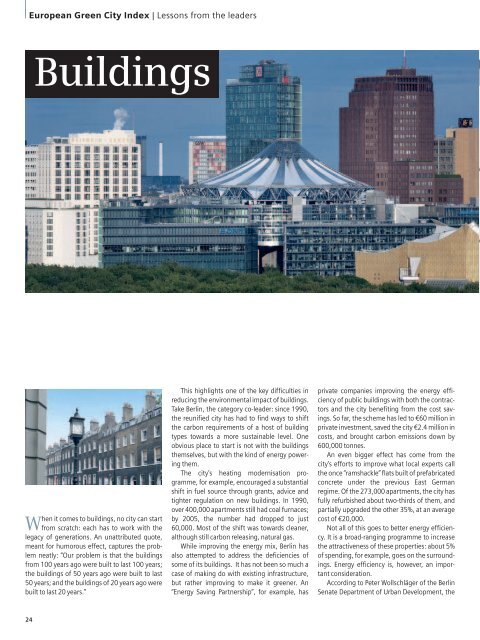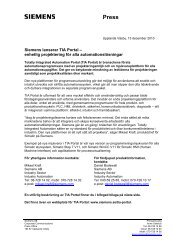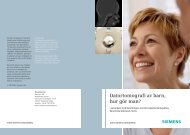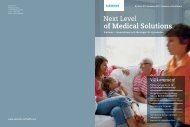European Green City Index - Siemens
European Green City Index - Siemens
European Green City Index - Siemens
Create successful ePaper yourself
Turn your PDF publications into a flip-book with our unique Google optimized e-Paper software.
<strong>European</strong> <strong>Green</strong> <strong>City</strong> <strong>Index</strong> | Lessons from the leaders<br />
Buildings<br />
When it comes to buildings, no city can start<br />
from scratch: each has to work with the<br />
legacy of generations. An unattributed quote,<br />
meant for humorous effect, captures the problem<br />
neatly: “Our problem is that the buildings<br />
from 100 years ago were built to last 100 years;<br />
the buildings of 50 years ago were built to last<br />
50 years; and the buildings of 20 years ago were<br />
built to last 20 years.”<br />
This highlights one of the key difficulties in<br />
reducing the environmental impact of buildings.<br />
Take Berlin, the category co-leader: since 1990,<br />
the reunified city has had to find ways to shift<br />
the carbon requirements of a host of building<br />
types towards a more sustainable level. One<br />
obvious place to start is not with the buildings<br />
themselves, but with the kind of energy powering<br />
them.<br />
The city’s heating modernisation programme,<br />
for example, encouraged a substantial<br />
shift in fuel source through grants, advice and<br />
tighter regulation on new buildings. In 1990,<br />
over 400,000 apartments still had coal furnaces;<br />
by 2005, the number had dropped to just<br />
60,000. Most of the shift was towards cleaner,<br />
although still carbon releasing, natural gas.<br />
While improving the energy mix, Berlin has<br />
also attempted to address the deficiencies of<br />
some of its buildings. It has not been so much a<br />
case of making do with existing infrastructure,<br />
but rather improving to make it greener. An<br />
“Energy Saving Partnership”, for example, has<br />
private companies improving the energy efficiency<br />
of public buildings with both the contractors<br />
and the city benefiting from the cost savings.<br />
So far, the scheme has led to €60 million in<br />
private investment, saved the city €2.4 million in<br />
costs, and brought carbon emissions down by<br />
600,000 tonnes.<br />
An even bigger effect has come from the<br />
city’s efforts to improve what local experts call<br />
the once “ramshackle” flats built of prefabricated<br />
concrete under the previous East German<br />
regime. Of the 273,000 apartments, the city has<br />
fully refurbished about two-thirds of them, and<br />
partially upgraded the other 35%, at an average<br />
cost of €20,000.<br />
Not all of this goes to better energy efficiency.<br />
It is a broad-ranging programme to increase<br />
the attractiveness of these properties: about 5%<br />
of spending, for example, goes on the surroundings.<br />
Energy efficiency is, however, an important<br />
consideration.<br />
According to Peter Woll schläger of the Berlin<br />
Senate Department of Urban Development, the<br />
city has found that the optimal, cost-effective<br />
measures for saving heat energy are insulation<br />
of the outer walls and top floor ceiling; new airtight<br />
windows; and renovation of the building’s<br />
heating system. These three measures reduce<br />
annual carbon emissions by between 1 and 1.4<br />
tonnes per flat.<br />
However, Mr Wollschläger points out that<br />
even over the long term the energy savings do<br />
not pay the entire cost of the refurbishment of<br />
these flats. The benefits extend beyond energy<br />
savings, however, such as lower maintenance<br />
costs for these flats given that the improvements<br />
reduce mould and mildew, as well as<br />
keeping temperatures more even. Quite simply,<br />
they are nicer places to live.<br />
The lessons which the city has learned could<br />
have a substantial impact worldwide. Across<br />
central and eastern Europe, the city estimates<br />
that there are nearly 50 million flats of similar<br />
construction, and in China there are about 200<br />
million.<br />
Between 2005 and 2007, through the Baltic<br />
Energy Efficiency Network for Building Stock<br />
(BEEN), Berlin shared its knowledge with cities<br />
in Poland and the Baltic states and worked with<br />
them on understanding how best to finance<br />
such renovation. Now the EU is funding the Urb<br />
Energy project to take things further, looking not<br />
just at individual buildings but at urban infrastructure<br />
and holistic rehabilitation of whole<br />
residential areas.<br />
By contrast, Stockholm, the other joint leader<br />
in the buildings category, has been at the forefront<br />
of energy-efficient building standards for<br />
some time. The city benefits from its extensive<br />
use of heat pumps, which make more efficient<br />
use of electricity for heating. Insulation standards<br />
are also high. All this pays off: Sweden has<br />
years of experience building homes with a total<br />
annual energy consumption of well below<br />
2,000 kwh, despite its cold climate. By contrast,<br />
new houses built in the UK that comply with the<br />
country’s latest energy-related building standards<br />
will consume an average of about 3,600<br />
kwh.<br />
Ideas from<br />
other cities<br />
From April 2010, London will start a trial<br />
scheme for retrofitting homes to save energy,<br />
providing some energy-efficiency equipment<br />
for free, such as low-energy light bulbs and<br />
standby switches, while charging for more<br />
advanced measures.<br />
Residents of Prague can benefit from a national<br />
Czech programme for retrofitting<br />
buildings with a €1 billion budget, which is financed<br />
from a sale of CO2 emission permits<br />
to Japan.<br />
In 2001, Vienna began permitting the construction<br />
of multi-storey buildings made primarily<br />
of timber. This has helped to bring<br />
about the development of a new kind of environmentally<br />
friendly passive housing.<br />
24 25

















